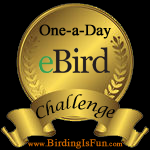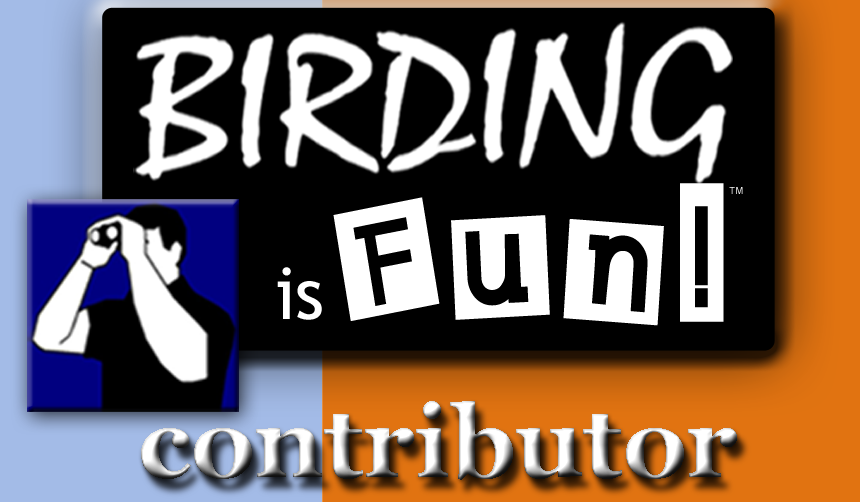Rock’n’rollers
32 minutes ago
Birding. All the time.
Skin Design:
Free Blogger Skins
 How much would you pay to travel across the country for a year birding with one of America's biggest birding celebrities? While such a trip might set you back tens of thousands of dollars, about $30 can get you the next best thing if you buy Pete Dunne's Essential Field Guide Companion. Reading this new book is like following Pete Dunne on an extended field trip across the continent as he rattles off his own impressions of over 700 bird species--including his own nicknames for the birds, tips on identifying them, their characteristic behaviors, and even unique aspects of the the way each species flies.
How much would you pay to travel across the country for a year birding with one of America's biggest birding celebrities? While such a trip might set you back tens of thousands of dollars, about $30 can get you the next best thing if you buy Pete Dunne's Essential Field Guide Companion. Reading this new book is like following Pete Dunne on an extended field trip across the continent as he rattles off his own impressions of over 700 bird species--including his own nicknames for the birds, tips on identifying them, their characteristic behaviors, and even unique aspects of the the way each species flies.Not many years ago, Professor Samuel Eliot (perhaps thinking of beginners for the next thousand years) bravely suggested new names for some of the more mistitled species. The northern water-thrush, which isn't a thrush at all, he said could be called 'bogbird'...if one is still distracted with the multiplicity of bird names and often confused by species that look very much alike, a simple solution is to work out a series of private and temporary names for harder species. The two water-thrushes, for instance, could almost pass for twins. One has a yellow line over the eye, the other a white one. Many observers can never remember which has which. Try privately calling one the 'wihte Louisiana' for a while, and the other the 'yellow northern.' In a surprising short time, a once-vexing personal problem will have benn permanently settled. This trick can be extended to many other species..."
 If you go back about 330 million years, there were no birds or people. If you could do your genealogy back that far, you would find that you shared ancestors with birds. These ancestors were four-legged animals similar to the fossils Westlothiana and Casineria. By about 313 million years ago, birds and humans still shared the same ancestors, amniotes similar to Protoclepsydrops and Hylonomus. (Image of Hylonomus from here, more images here)
If you go back about 330 million years, there were no birds or people. If you could do your genealogy back that far, you would find that you shared ancestors with birds. These ancestors were four-legged animals similar to the fossils Westlothiana and Casineria. By about 313 million years ago, birds and humans still shared the same ancestors, amniotes similar to Protoclepsydrops and Hylonomus. (Image of Hylonomus from here, more images here)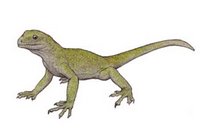 By 309 to 302 million years ago, the ancestors of birds had separated from our ancestors to become a distinct lineage that would include lizards, crocodiles, dinosaurs and birds. These early bird ancestors were similar to Petrolacosaurus, (image from here, more images here) , the oldest known diapsid reptile, which hales from the Rock Lake Shale of the Stanton Formation near Garnett, Kansas (perhaps to the chagrin of people in that state with other views about the origins of birds).
By 309 to 302 million years ago, the ancestors of birds had separated from our ancestors to become a distinct lineage that would include lizards, crocodiles, dinosaurs and birds. These early bird ancestors were similar to Petrolacosaurus, (image from here, more images here) , the oldest known diapsid reptile, which hales from the Rock Lake Shale of the Stanton Formation near Garnett, Kansas (perhaps to the chagrin of people in that state with other views about the origins of birds). Our own ancestors at this time were more similar to Protoclepsydrops and Archaeothyris (image from here), some of the earliest synapsids. As you can see from these images, the ancestors of both birds and humans were pretty much lizard-people (perhaps another reason I always liked lizards?).
Our own ancestors at this time were more similar to Protoclepsydrops and Archaeothyris (image from here), some of the earliest synapsids. As you can see from these images, the ancestors of both birds and humans were pretty much lizard-people (perhaps another reason I always liked lizards?).  Over the past 300 million years, the descendents of Protolepsydrops and Petrolacosaurus have gone their separate evolutionary ways, though sharing the planet the entire time. Looking back now over perhaps 300 million generations of birds, and perhaps just a few million fewer generations of diapsids, mammals, primates, and humans, its perhaps easier to think that we are very different from each other. While in many ways this is true, part of the joy of living with birds is the quest to determine how much we share with our distant kin, as well as to wonder how our two different lineages could have given rise to so many wonderful creatures after separating from each other back in the Carboniferous. (Owl photo: here)
Over the past 300 million years, the descendents of Protolepsydrops and Petrolacosaurus have gone their separate evolutionary ways, though sharing the planet the entire time. Looking back now over perhaps 300 million generations of birds, and perhaps just a few million fewer generations of diapsids, mammals, primates, and humans, its perhaps easier to think that we are very different from each other. While in many ways this is true, part of the joy of living with birds is the quest to determine how much we share with our distant kin, as well as to wonder how our two different lineages could have given rise to so many wonderful creatures after separating from each other back in the Carboniferous. (Owl photo: here) Last night I finished reading Animals in Translation by autistic animal researcher Temple Grandin. I always like Grandin's books, because she makes animal behavior so accessible to the average reader. In this book, she goes farther than she has before to explain just why animals do what they do. In doing so, she draws upon research in many academic fields, as well as her own experience designing humane slaughterhouses for domestic animals.
Last night I finished reading Animals in Translation by autistic animal researcher Temple Grandin. I always like Grandin's books, because she makes animal behavior so accessible to the average reader. In this book, she goes farther than she has before to explain just why animals do what they do. In doing so, she draws upon research in many academic fields, as well as her own experience designing humane slaughterhouses for domestic animals.LaMMNA has just successfully completed its first season of avian influenza monitoring and we thank all those who participated. A total of 33 member organizations from 21 states participated, representing a wide range of operations from small, single-operator stations to large multi-station observatories. They captured 20,000 birds during their spring operations at 40 stations. Of those, they sampled 1,000 birds with cloacal swabs, pulling tail feathers for DNA analysis. The samples are now on their way to UCLA for analysis.
A man died of H5N1 flu in Beijing in November 2003 - two full years
before China admitted any human cases of H5N1. The death of the 24-year-old from bird flu came months before China even admitted H5N1 was circulating in its poultry. The man was tested for respiratory illness because of concern in the wake of the SARS epidemic.
It is not clear when the Chinese scientists who reported the finding discovered this, but they tried to withdraw their paper from the New England Journal of Medicine at the last minute on Wednesday. It was too late to prevent publication.
The case suggests that, as has long been suspected, many more people have caught H5N1 flu in China than have been reported, and for a longer time. The more human cases there are, the more chances the virus has to evolve into a human pandemic strain of flu.
 In 1803, John James Audubon wrote about his experience with Eastern Phoebes nesting behind his house along Perkiomen Creek west of Philadelphia:
In 1803, John James Audubon wrote about his experience with Eastern Phoebes nesting behind his house along Perkiomen Creek west of Philadelphia:"When they were about to leave the nest, I fixed a light silver thread to the leg of each, loose enough not to hurt the part, but so fastened that no exertions of theirs could remove it. At the next year's season when the Phoebe returns to Pennsylvania I had the satisfaction to observe those [birds nesting in the Perkiomen] cave and about it. Having caught several of these birds on the nest, I had the pleasure of finding two of them had the little ring on the leg."

 One of the things I love about birds and other animals, are the evolutionary ties that bind us together over hundreds of millions of years. Birds have been flying about since the Mesozoic Era, when our own ancestors were small creatures that looked almost nothing like us. A find published today in Science reveals the earliest known "modern" bird--something that looks like a duck or a loon. Earlier birds belonged to orders that have since died out, but this bird (Gansus yumenensis) appears more closely related to the birds that survived the extinction at the end of the Cretaceous Period about 65 million years ago. See a story about the find here.
One of the things I love about birds and other animals, are the evolutionary ties that bind us together over hundreds of millions of years. Birds have been flying about since the Mesozoic Era, when our own ancestors were small creatures that looked almost nothing like us. A find published today in Science reveals the earliest known "modern" bird--something that looks like a duck or a loon. Earlier birds belonged to orders that have since died out, but this bird (Gansus yumenensis) appears more closely related to the birds that survived the extinction at the end of the Cretaceous Period about 65 million years ago. See a story about the find here.
 One of the highlights of my trip to Aullwood was getting to spend a little bit of time with Richard Louv, author of Last Child in the Woods. His book is a review of the importance of nature experiences for the development of children, and how Americans are losing those experiences and kids are suffering "nature deficit disorder" because of loss of accessible natural areas and increasingly indoor suburban lifestyles. While playing with some box turtles at the Aullwood center, Richard told a few of us about his experiences with box turtles as a kid.
One of the highlights of my trip to Aullwood was getting to spend a little bit of time with Richard Louv, author of Last Child in the Woods. His book is a review of the importance of nature experiences for the development of children, and how Americans are losing those experiences and kids are suffering "nature deficit disorder" because of loss of accessible natural areas and increasingly indoor suburban lifestyles. While playing with some box turtles at the Aullwood center, Richard told a few of us about his experiences with box turtles as a kid.  Just got back from a couple days at an Audubon Educators conference at the Aullwood Nature Center near Dayton, Ohio. Nice drive there and back, and some good walks there in the woods. I saw 50 species one morning in the woods including a nice female Yellow-throated Warbler that dropped down to look at us from high in a sycamore. Also, nesting bluebirds and Indigo Buntings. You know you are seriously addicted to birds when you only get the tiniest buzz from two hours and 50 species of Eastern woodland birds. Too many meetings, not enough birds! More cool were the Timber Rattlesnake and Massasauga in the nature center.
Just got back from a couple days at an Audubon Educators conference at the Aullwood Nature Center near Dayton, Ohio. Nice drive there and back, and some good walks there in the woods. I saw 50 species one morning in the woods including a nice female Yellow-throated Warbler that dropped down to look at us from high in a sycamore. Also, nesting bluebirds and Indigo Buntings. You know you are seriously addicted to birds when you only get the tiniest buzz from two hours and 50 species of Eastern woodland birds. Too many meetings, not enough birds! More cool were the Timber Rattlesnake and Massasauga in the nature center.
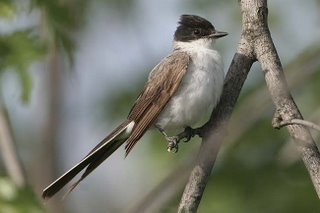 I had company all weekend, didn't have email access, and had a funeral to go to this morning--perfect timing for a rare bird to show up! When I got in to work today I found out about a Fork-tailed Flycatcher seen yesterday about half an hour away from my office. Finally, after the funeral, I took off with Paul Green to chase this nemesis bird along the Delaware River in Morrisville (photo: Adrian Binns).
I had company all weekend, didn't have email access, and had a funeral to go to this morning--perfect timing for a rare bird to show up! When I got in to work today I found out about a Fork-tailed Flycatcher seen yesterday about half an hour away from my office. Finally, after the funeral, I took off with Paul Green to chase this nemesis bird along the Delaware River in Morrisville (photo: Adrian Binns).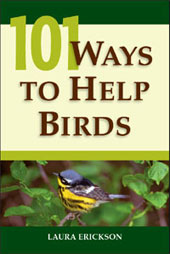 A couple of years ago, I was teaching a class on urban bird conservation at the University of Texas, when I learned that Laura Erickson, who I knew from the Conservationthrougbirding listserv, was writing a book entitled 101 Ways to Help Birds. She shared her 101 ideas with me, and I shared them with my class. I commented on a couple chapter drafts, and have been anxiously awaiting the book in print.
A couple of years ago, I was teaching a class on urban bird conservation at the University of Texas, when I learned that Laura Erickson, who I knew from the Conservationthrougbirding listserv, was writing a book entitled 101 Ways to Help Birds. She shared her 101 ideas with me, and I shared them with my class. I commented on a couple chapter drafts, and have been anxiously awaiting the book in print.Brussels, 31 May 2006
Avian Influenza: Results of EU surveillance in wild birds presented
The European Commission and the Community Reference Laboratory (CRL) for Avian Influenza in Weybridge have published the results of the surveillance for avian influenza in wild birds carried out in the EU over the past 10 months. The extensive epidemiological data was presented today at the FAO/OIE International Scientific Conference on Avian Influenza and Wild Birds, which is taking place in Rome this week. Although final figures are still being collected for February-May 2006, it is estimated that around 60 000 wild birds were tested for avian influenza in the EU during that period. This, combined with the 39 000 wild birds tested between July 2005-January 2006, means that almost 100 000 tests for the H5N1 virus have been carried out on wild birds over the past 10 months. Since February 2006, over 700 wild birds across 13 Member States have been found to be infected with the H5N1 “Asian strain” of avian influenza. However, a positive decline in the incidence of the disease in wild birds in Europe has also been noted over the past weeks.
Markos Kyprianou, Commissioner for Health and Consumer Protection, said “Extensive surveillance for avian influenza in wild birds and poultry has been one of the key tools used by the EU to fend off the virus over the past months. It is a fundamental component in minimising the introduction and spread of this disease which poses a serious threat to animal and public health. The Commission and the Member States are continually working to improve the preventive measures already in place against avian influenza, so as to ensure that we have the tightest possible defences against it. We cannot let down our guard when it comes to avian influenza, as it is likely to remain a threat for Europe and the rest of the world for many months to come.”
Between February 2006 and 21 May 2006, 741 cases of highly pathogenic avian influenza (most of them confirmed as H5N1) have been detected in wild birds in 13 Member States – Greece, Italy, Slovenia, Hungary, Austria, Germany, France, Slovakia, Sweden, Poland, Denmark, Czech Republic and UK. There have been only four outbreaks of H5N1 avian influenza in poultry in the EU, and all of these were swiftly eradicated following detection. No human case of the H5N1 virus has occurred in the EU.
There is considerable variation in the number of cases of highly pathogenic avian influenza in wild birds, ranging from 326 in Germany to 1 in the UK (see chart 1). The peak in terms of the number of cases in wild birds was reached in March with 362 cases (compared to 200 in February), with cases declining to 162 in April and 17 in May (until 21 May – see chart 2). The most commonly affected wild birds have been swans (see chart 3), representing 62,8% of the total, followed by ducks (16,3%), geese (4,5%), birds of prey (3,9%) and others (13%).
Following the major geographical spread of the H5N1 avian influenza virus from South-East Asia in 2005, the EU has intensified its programmes for the surveillance and early detection of avian influenza, both in wild birds and poultry. Almost €2.9 million has been made available by the Commission to co-finance Member States’ surveillance programmes for the period July 2005-December 2006 (see IP/06/172 ). Guidelines on enhanced surveillance for avian influenza in wild birds were also issued by the Standing Committee on the Food Chain and Animal Health. The intensified surveillance has enabled the Commission and Member States to gain a clearer view of the avian influenza situation in the EU, and to rapidly detect and respond to any outbreaks.
For the Commission and CRL presentations and the surveillance results, see here

